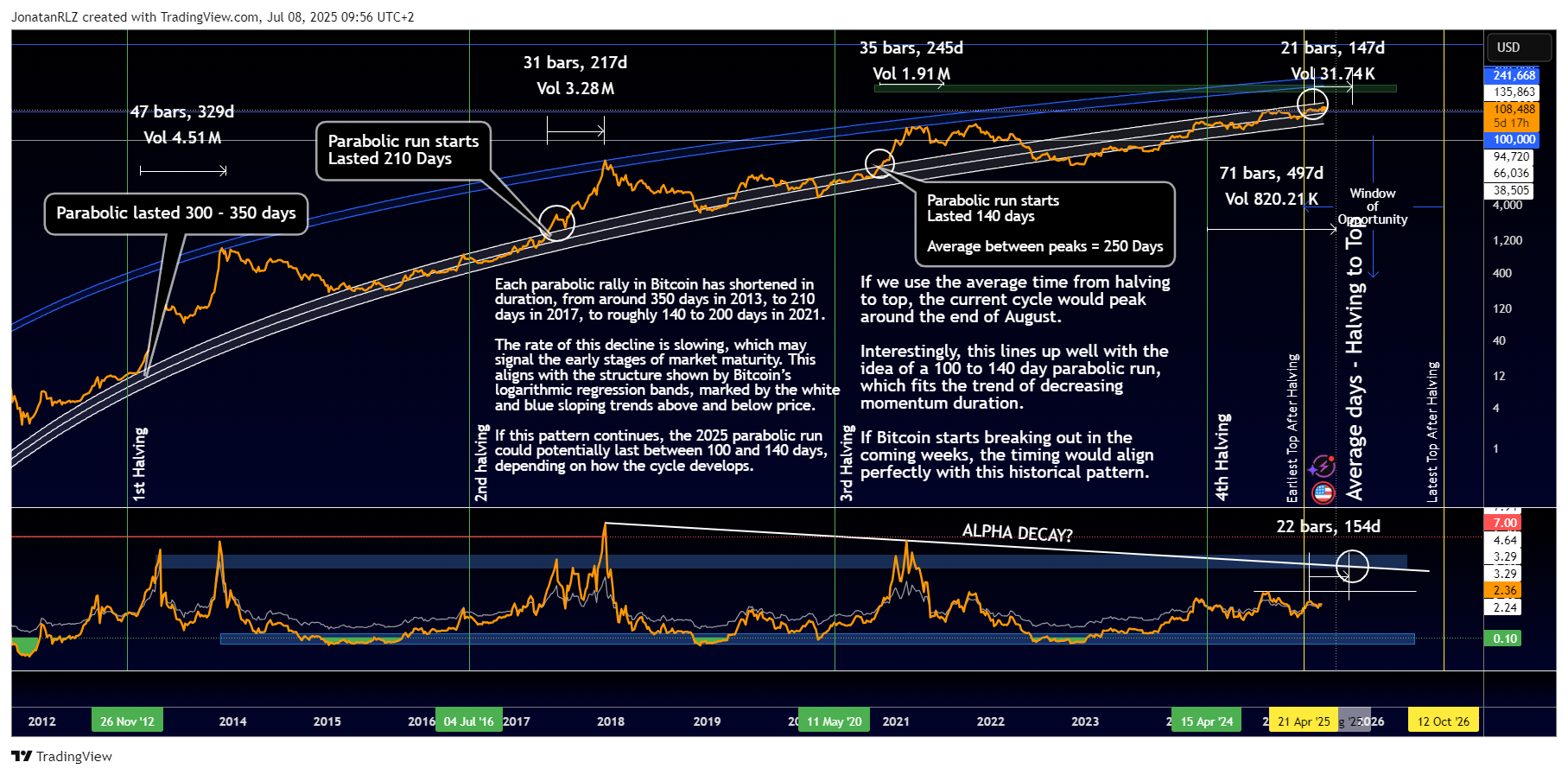As we move deeper into the post halving phase of 2025, it is worth stepping back to analyse Bitcoin’s high time frame structure. By combining price action with key indicators, we can better understand where we are in the current cycle and what may lie ahead.
On the weekly chart, set to a logarithmic scale, we have overlaid Bitcoin’s logarithmic regression bands. This indicator works best on a log scale chart, where the y-axis on the right side adjusts to reflect percentage changes in price rather than absolute dollar values. This adjustment provides a clearer view of Bitcoin’s long-term growth and volatility. Historically, the white lower band has marked out major cycle bottoms, while the blue upper bands have often coincided with parabolic tops.
Looking back, each major bull run began after the price either exited or bounced off the lower band. The first rally, following the 2012 halving, lasted around 350 days. The second, after the 2016 halving, ran for approximately 210 days. The third, post 2020 halving, was slightly different, showing twin peaks but averaging between 140 and 200 days overall.
While each parabolic phase has been shorter than the last, the rate of this decline is slowing. This may signal Bitcoin’s gradual move toward market maturity. If the trend holds, the current 2024 to 2025 cycle could see a parabolic phase lasting between 100 and 140 days. Using the historical average time from halving to market top, this cycle’s peak may fall between August and October 2025. The earliest post halving top came in April, which we have already passed, and the latest was in October, giving us a clear window of opportunity.
Supporting this view is the MVRV Z Score shown at the bottom of the chart. This metric measures how far Bitcoin’s market value deviates from its realised value. Historically, major cycle bottoms occurred when the MVRV entered its green buy zone, while all significant tops coincided with readings in the extreme red zone.
A notable feature of this indicator for Bitcoin is the declining trendline across MVRV Z Score peaks, pointing to a phenomenon known as alpha decay. As Bitcoin matures and volatility compresses, each bull market top has occurred at progressively lower MVRV levels. Previous peaks reached seven to eight, but if the trend continues, a peak closer to five could define this cycle’s high.
Together, the logarithmic regression bands and MVRV Z Score form a powerful high time frame framework. Both suggest that Bitcoin remains in its post halving growth phase, though future tops may become less explosive as institutional adoption and market depth increase.
Some argue that this maturation could make Bitcoin behave more like traditional assets, with steadier price movements. Others believe growing institutional involvement might trigger a so-called super cycle, breaking away from historical patterns entirely.
For now, Bitcoin remains within its logarithmic progression channel. How the price interacts with these high time frame indicators in the months ahead will be critical in determining whether we see another parabolic breakout or the start of a more stabilised market structure.

Trading involves risk.
The content provided here is for informational purposes only. It is not intended as personal investment advice and does not constitute a solicitation or invitation to engage in any financial transactions, investments, or related activities. Past performance is not a reliable indicator of future results.
The financial products offered by the Company are complex and come with a high risk of losing money rapidly due to leverage. These products may not be suitable for all investors. Before engaging, you should consider whether you understand how these leveraged products work and whether you can afford the high risk of losing your money.
The Company does not accept clients from the Restricted Jurisdictions as indicated in our website/ T&C. Some services or products may not be available in your jurisdiction.
The applicable legal entity and its respective products and services depend on the client’s country of residence and the entity with which the client has established a contractual relationship during registration.




